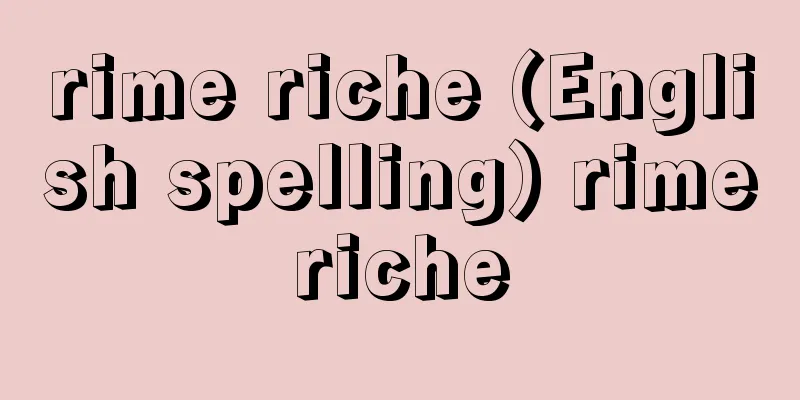Pachinko - Pachinko

|
A type of gambling game. It is unique to Japan, where players play alone against a machine that uses a spring to bounce steel balls and dispenses 10 or more balls when they fall into holes on the board. It is said to have evolved from the Corinth Game, which was introduced from America in 1920 (Taisho 9). It was originally aimed at children, but in 1925 the machine was improved to dispense 3 to 7 balls, and the first pachinko specialty store for adults opened in Osaka. It was completely banned in 1942 (Showa 17) during World War II, but was resumed first in Kanazawa and Kurume, Fukuoka Prefecture, immediately after the war, then in Tokyo, Osaka, and became popular nationwide. The prizes exchanged for balls were mostly everyday items such as cigarettes, chocolates, and canned goods, but as people became more affluent, large stores began to stock decorative items such as handbags. After the first boom in 1953 (Showa 28) and the second boom in 1960, the pachinko boom peaked in 1994 (Heisei 6) with 29.3 million players and sales of 30.473 trillion yen, making it a huge business on a par with the automobile industry. After that, due to the high level of gambling machines leading to higher spending at pachinko parlors and the effects of the recession, the market went on a downward trajectory, with the player population at 19.3 million and sales of 27.807 trillion yen in 2001 (Heisei 13), 14.5 million players and sales of 22.98 trillion yen in 2007, and 9 million players and sales of 19.54 trillion yen in 2017. Pachinko established itself as a form of entertainment for the masses when 13,585 pachinko parlors (according to the National Police Agency in 2007) were scattered across the country and became established as a leisure activity that could be enjoyed whenever one wanted, and when, in response to the maturation of the nation's lifestyle, pachinko parlors made efforts to satisfy the gambling desire within the limits of the Entertainment and Amusement Business Control Law (Law on the Regulation and Optimization of Entertainment and Amusement Businesses, etc.). However, in the summer of 1996, there were a series of accidents in which housewives who were obsessed with pachinko left their young children in the car and died in the heat, exposing the problems of addiction and excessive gambling, which became a social issue. Furthermore, counterfeit prepaid cards were introduced to make accounting more transparent, causing huge losses. In response, industry associations removed 700,000 machines in October 1996, including machines that led to high gambling desires due to the high winnings and losses. The machines used for playing have diversified since 1965, when coin-operated slot machines (pachislot machines) were added, and in 2001 alone, 234 types of pachinko and 347 types of pachislot machines were released on the market. The following machines were all the rage: In 1949, the Masamura Gauge, which is said to have laid the foundation for the prosperity of pachinko, featured irregular nails on the face of the wheel, giving the balls a unique movement; in 1952, the all-20-shot type, which could be operated with one hand and created the first boom; in 1960, the Tulip machine, which opened a tulip-shaped hole when the ball fell into a specific hole, which was the basis of the second boom; around 1972, an electric handle pachinko machine; and in 1981, the Fever type, in which the number on the wheel changed every time the ball fell into a hole, and a hole opened for a set period of time when three specific numbers were lined up. 1992: A card reader (CR) machine exclusively for prepaid cards. After that, CR machines using prepaid cards instead of cash machines became mainstream in pachinko. CR machines became more and more like gambling, with the emergence of probability fluctuations (systems that increase the probability of winning by meeting set conditions), and the industry implemented a series of self-regulations to curb gambling. Pachislot machines also began to feature a stock function that allowed players to accumulate jackpots, further increasing the gambling nature of the machines. For this reason, the regulations of the Entertainment and Amusement Business Control Law were revised in 2004 to change high gambling machines to those with moderate gambling and rich playability, and after a three-year transitional period, all gaming machines have been of moderate gambling nature since October 2007. With a sense of crisis that the long-term downward trend in the number of gamers and sales must be halted, the industry is united in launching a campaign to spread gaming machines with moderate gambling nature (commonly known as Yu-pachi) throughout the country. [Kuramochi Sadasuke] In 2016, the Integrated Resort Promotion Act (officially known as the Act on Promoting the Development of Specified Integrated Resort Areas (Act No. 115 of 2016), commonly known as the Casino Act), was enacted to include measures to combat gambling addiction. In 2017, the Enforcement Regulations of the Entertainment and Amusement Business Control Act were amended to reduce the number of balls paid out in the event of a jackpot to about two-thirds of the previous amount (the same applies to pachislots. Transitional measures will last for three years). The interpretation and implementation standards of the Entertainment and Amusement Business Control Act were also partially revised, and addiction prevention measures (warning customers, providing information about consultation services, educating employees, etc.) were added to the obligations of game facility managers. [Editorial Department, September 17, 2019] "The History of Pachinko" by Norifumi Mizogami (1999, Banseisha)" ▽ "Leisure White Paper, compiled and published by the Leisure Development Center, various editions" [References] | |Source: Shogakukan Encyclopedia Nipponica About Encyclopedia Nipponica Information | Legend |
|
射幸遊技の一種。鋼製の玉をばねではじき、盤面の穴に入ると10個以上の玉が出る機械を相手に、1人で楽しむ日本特有のもの。1920年(大正9)にアメリカから伝えられたコリント・ゲームから変化したものといわれる。初めは子供を対象としたが、1925年機械を改良して、3個ないし7個の玉が出るようにし、大人を対象にしたパチンコ専門店が初めて大阪で開業した。第二次世界大戦中の1942年(昭和17)に全面禁止となったが、終戦直後まず金沢、福岡県久留米(くるめ)で再開され、次いで東京、大阪、さらに全国的に流行した。玉と交換する景品もたばこ、チョコレート、缶詰など日用品が大部分を占めたが、生活が豊かになるにしたがって、大型店ではハンドバッグなどの装飾品も取りそろえるようになった。1953年(昭和28)の第一期、1960年の第二期ブームを経て、パチンコ・ブームがピークになったのは1994年(平成6)で、遊技人口2930万人、売上げ30兆4730万円と、自動車産業と並ぶ巨大ビジネスに成長した。その後、高射幸性機によりパチンコ店での使用金額が高額化したことや不況の影響などもあり下降線をたどり、2001年(平成13)には遊技人口1930万人、売上げ27兆8070億円、2007年には1450万人、22兆9800億円、2017年には900万人、19兆5400万円となっている。 パチンコが大衆娯楽としての地位を確立したのは、1万3585(2007年、警察庁調べ)の店が全国に散らばり好きなときに楽しめるレジャーとして定着したこと、国民生活の成熟にあわせ風俗営業等取締法(風俗営業等の規制及び業務の適正化等に関する法律)の範囲内で射幸性を満足させるくふうを重ねたこと、などがあげられる。しかし、1996年夏には、パチンコに夢中になった主婦が幼児を車の中に置き去りにして暑さで死亡させる事故が相次ぎ、依存症や高すぎる射幸性の問題などが露呈、社会問題になった。さらに、経理を透明化するために導入されたプリペイドカードで偽造カードが出回り、巨額の損害を出した。これに対応して業界団体は1996年10月、高額な勝ち負けで射幸性の加熱傾向を招く機械など、70万台を撤去した。 遊技に使われる機械は、1965年からはコインを使用するパチスロ(回胴式遊技機)も加わって多様化しており、2001年だけでもパチンコ234種、パチスロ347種が市場に投入された。一世を風靡(ふうび)した機械として、以下のものがある。1949年、パチンコ繁栄の基礎を築いたといわれる、盤面の釘(くぎ)を不規則にして玉の動きに妙味を与えた正村(まさむら)ゲージ。1952年、第一期ブームを築いた片手だけで操作できるオール20連発式。1960年、第二期ブームのもととなった特定の穴に玉が入るとチューリップ形の穴が開くチューリップ機。1972年ごろ、電動式ハンドルパチンコ機。1981年、玉が穴に入るたびに盤面の数字が変わり、特定の三つの数字がそろうと穴が一定時間開くフィーバー式。1992年、プリペイドカード専用のカードリーダー(CR)機。 その後、パチンコは、現金機にかわってプリペイドカードを使用するCR機が主流となった。CR機では、確率変動(決められた条件により大当りの確率が上昇するシステム)が相次いで登場するなど射幸性が高まり、業界では射幸性を抑える自主規制が相次いだ。また、パチスロも、大当りをためるストック機能をもつ機種が登場し、射幸性が一段と強まった。 このため、2004年に風俗営業等取締法の規則が改正され、高射幸性機を適度な射幸性で遊技性に富む機種にかえることになり、3年の経過措置期間を経て、2007年10月以降は、すべて適度な射幸性をもつ遊技機となった。遊技人口、売上高の長期低落傾向に歯止めをかけなければならないという危機感を背景に、適度な射幸性の遊技機(通称、遊パチ)を全国に広めようと、業界は一体となってキャンペーンを展開している。 [倉茂貞助] 2016年に成立した「統合型リゾート(IR)推進法」(正称「特定複合観光施設区域の整備の推進に関する法律」(平成28年法律第115号)。通称「カジノ法」)にギャンブル依存症対策の実施が盛り込まれたことを受けて、翌2017年に風俗営業等取締法の施行規則が一部改正され、大当りした場合の出玉(でだま)を従来の3分の2程度とすることなった(パチスロについても同じ。経過措置期間3年)。また風俗営業等取締法の解釈運用基準も一部変更され、遊技場管理者の義務として依存防止対策(客への注意喚起、相談窓口に関する情報提供や従業員への教育など)が加えられた。 [編集部 2019年9月17日] 『溝上憲文著『パチンコの歴史』(1999・晩聲社)』▽『余暇開発センター編・刊『レジャー白書』各年版』 [参照項目] | |出典 小学館 日本大百科全書(ニッポニカ)日本大百科全書(ニッポニカ)について 情報 | 凡例 |
Recommend
Flowering disease - Blooming disease
Bamboo normally does not flower, but rather gradua...
Tentara Pembela Tanah Air (English)
...The Indonesian military force trained by the J...
Indigofera sumatrana (English spelling)
…【Arai Yoshie】. … *Some of the terminology that m...
Karōnin - Karōnin
…It is found from southern Hokkaido to the Ryukyu...
Administrative contract - Gyosei Keiyaku
A contract between an administrative body and ano...
free entry
...When a new company tries to set up new facilit...
Music School - Ongaku Kyouushitsu
... After the war, there was a reflection on the ...
Daniels, FJ
… It was during World War II that British univers...
serliana
…There remains an incomplete manuscript dealing w...
Joan Naito
Year of death: 1626 Year of birth: Unknown. A Chri...
Cote française des Somalis (English)
…The majority of the residents are Muslim. [histo...
Manseki Rebellion - Manseki no Ran
A slave rebellion during the military government o...
Adolph Simon Ochs
1858‐1935 American newspaper executive. Born in Ci...
Kasuyu sake - Kasuyu sake
〘Noun〙 Sake dregs dissolved in hot water. ※Man'...
Moth - Moth
A common name for insects belonging to the order L...





![Urawa [city] - Urawa](/upload/images/67cb01416648f.webp)



